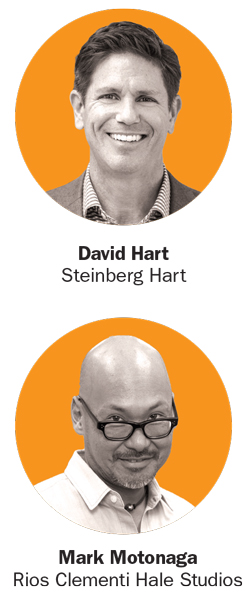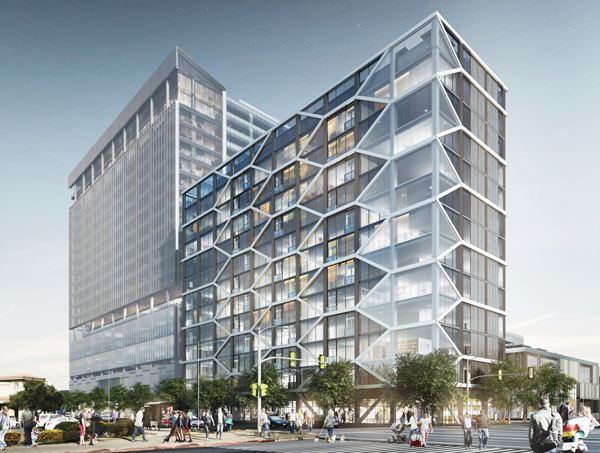In Los Angeles, big-name developers are often revered for transforming the city skyline. They tend to get most of the credit, and more often than not, the big bucks.
But to build a project from the ground up, many different moving pieces have to align — literally and figuratively — with crucial but sometimes less visible players, like architects, keeping a lower profile.
But as of late, the game seems to be changing.
Capitalizing on the development boom of the past few years, architecture firms in L.A., both big and small, are exploring new ways of improving their profit margins. While some firms are exploring unconventional commission structures or taking equity stakes in their projects, others are dipping into new revenue streams, such as designing custom furniture.
Under some of the new payment structures, architecture firms are bringing in anywhere from 5 to 20 percent more in fees than they previously did with a flat payment structure, industry experts said. In 2015, the top 10 largest architecture firms in the country — including Gensler and AECOM — collectively pulled in $2.8 billion, according to the Giants 300 Report. The total figure increased to nearly $3.6 billion in 2017, reflecting a 29 percent increase in revenue overall. Experts credit that rise in part to the more holistic set of services architecture firms increasingly offer.
“The way we’ve been doing our work has changed,” said Kelly Farrell, executive vice president at Baltimore-based CallisonRTKL, which has designed a bevy of L.A. projects. While firms are “happy to produce a set of drawings,” an architect’s value is much greater when providing information beyond designs, such as intel on user preferences and other consulting services, she said.
The sentiment is being echoed by developers. Jason Illoulian, CEO of Faring, said the architects he hires are “fully integral” to his projects.
“We like having one shop that can do everything for us, from planning stages to architectural stages to design to construction,” he said. “We’re leaning on them way more.”
For Faring, architects started playing a bigger role in recent years as a way to combat vocal and sometimes litigious neighborhood groups. Illoulian said that “architects add the most value when they can listen to these groups and help design a project” that’s in line with residents’ vision for the neighborhood, foregoing a drawn-out battle that can often delay projects by several years.

Raising the stakes
Beyond the services rendered, some firms are adding a more tangible source of value to projects. In a few cases, architects are now sourcing their own money — from their firm’s bank account or even their own personal savings — for an equity stake in projects they are designing. While the structure varies per project, it often translates to a smaller upfront fee for the firm and a bigger check once the project starts being profitable.
Stakes can vary from 1 percent in large multifamily or office projects to as much as 10 percent for single-family homes, sources said.
Rios Clementi Hale Studios, a firm based near Crenshaw, has recently been seeking equity in its projects. The firm’s financial diversification is not new; it began a few decades ago when it started designing lifestyle products, such as dining ware. But it’s only in more recent years that it has expanded into real estate development.
Mark Motonaga, creative director at the firm, said owning real estate created a way for the firm to get value through development, and basically invest in the firm by owning its own office “rather than giving back the money of a lease.”
In the company’s new equity arrangements, Rios Clementi Hale will typically operate on an “at-cost” model, meaning it takes a reduced fee in the beginning to cover its labor and some of the overhead cost. It then earns its profit with its equity stake, Motonaga said.
In 2018, the firm invested in a single-family spec home it was designing in Trousdale Estates that is currently on the market. It has since upped the stakes in its involvement in spec homebuilding, taking an equity position in an eight-property portfolio it is designing in Palm Springs.
“It is a model that gives us the ability to operate differently,” Motonaga said. “We’ve seen a lot of ups and downs in the market, and having the ability to have different income streams allows us a bit of resilience as a company.”
M-Rad Architecture, a smaller firm based in Culver City, is another company that has been increasingly investing in its own projects. The firm now invests in about 75 percent of the work it designs.
“It started out of necessity more than anything else,” recalled Matthew Rosenberg, its founder and CEO (and subject of TRD’s “At the Desk of” feature). “I was charging $800 for projects to just build a body of work. But then I realized that if I wasn’t charging enough, at least I should be able to get something on the back end.”
The $800 flat fee lasted for about a year after M-Rad launched in 2012. Yet even today, Rosenberg said, sometimes his firm “still works for free or on spec,” though that position now necessitates an equity stake.
M-Rad currently holds a 1 percent stake in the Green Street Building, a 68,000-square-foot office building in Downtown Los Angeles geared solely toward businesses in the cannabis industry. It also has stakes in three single-family projects, including a 6 percent stake in the 16,500-square-foot Bellagio Residence in Bel Air.
But operating on this model brings certain risks, as the payout may not come for several months or years, after the project breaks even. On the bright side, it is not necessary for a building to sell to make back an investment in the project, Rosenberg said. When the tenants start paying rent, M-Rad will get some dividends through that after taxes and other expenses are accounted for.

“If I can have 10 equity stakes in properties, then [the dividends] are paying for my entire [M-Rad headquarters] mortgage,” Rosenberg said. “It adds up pretty quickly.”
For projects where M-Rad is an investor, the firm might take an upfront fee that is anywhere from 5 to 100 percent less than what it usually would, depending on the structure of the partnership and stake, Rosenberg said.
“The tough part in it is survival,” he continued. “How do you give up so much fee and put cash in without risking the survival of your company?”
The short answer? The payoff.
Rosenberg said M-Rad generally assumes a 20 percent additional return with equity projects as opposed to flat-fee work. He expects this to increase to 35 percent in the coming years.
Design-build
Another way to change the game — and perhaps assume less risk than taking an equity stake — is for an architecture firm to get involved in a project earlier than it might have in the past.
Cuningham Group, which has two offices in California, and Steinberg Hart, which has four offices in the state, have been taking on more design-build projects in recent years. As opposed to design-bid-build, where the developer has separate contracts with a contractor and architect, design-build projects put the architects and contractor under one contract with the property owner or developer.
The model allows architects to work in conjunction with the contractor and other partners early, which helps with estimating the project costs and delivery schedule, said Lee Brennan, principal at Cuningham. “I don’t think any of us like those projects where we drew things and hope the contractor would come in on budget,” he added.
Generally, design-build projects tend to pull in 5 to 10 percent more in fees than a flat payment structure, according to several C-suite-level architects. For projects that are drastically redesigned or amended, a smaller increase of 1 to 5 percent is more standard.

Gensler and Steinberg Hart entered P3 agreements to design the V6 project in Koreatown.
“We find that we have a bigger piece of the pie when we’re in design-build,” David Hart, president and CEO of Steinberg Hart, said. “We become more of a strategic partner with the team rather than just an architect, and usually that has some recognized value as it relates to our fee.”
Within the old design-bid-build paradigm, the owner hired an architect to design a project and later solicited bids from contractors who would build the project. In theory, it allowed the owner to obtain multiple bids and then choose the most qualified and least expensive bidder.
One benefit to the traditional model was that it allowed for some more innovative projects, given that the architect wasn’t as concerned with the final cost, Brennan said. Overall, however, it was an “adversarial” model that pitted architects and contractors against each other and often led to more expensive projects, he explained. The new model makes the architect more of a partner in the process, Brennan and other architects said. It allows the firms to weigh in on materials, budget and expected delivery dates — all things they wouldn’t have had as much of a say in otherwise.
“In design-build, we are all part of a team and are communicating better to make sure that the project progress is better-managed and less conflict occurs,” Brennan added.
The new arrangement has been especially popular among his firm’s health care clients. Cuningham Group is currently working on a $145 million expansion and renovation for Dignity Health’s Mercy Southwest Campus in Bakersfield, expected to be completed in mid-2022.
You down with PPP?
Public-private partnerships — known as PPP or P3 — are not new by any stretch, but they’ve slowly been gaining popularity among architects looking to take on large, ambitious projects.
P3 projects involve a long-term agreement between the public sector, such as a city or municipal institution, and a private developer. The public sector often will tap a developer to largely lead and fund a project, and then slowly pay the developer through a ground lease that could extend for decades.
For architects, P3 projects don’t necessarily command a higher fee, said John Adams, managing director and principal at Gensler’s L.A. office. A developer will often negotiate an architect’s fee and later present a combined project cost to the public entity.
Many municipalities and bigger institutions, like private colleges, are moving into the P3 space, as it allows them to take on larger projects without having to pay millions of dollars upfront, Adams said. “It becomes more affordable to cities that have a budget, or don’t want to go out and get a bond through a ballot initiative,” he added.
Gensler has been taking on more P3 projects, though they still represents a small fraction of its business, according to Adams.
Steinberg Hart has worked on two P3 projects recently: the Vermont Corridor project near Koreatown, developed in conjunction with Trammell Crow and L.A. County, and the Sage Park Apartments in Gardena, a $28 million property.
And there are other ways that traditional processes are evolving for architects. Farrell, of CallisonRTKL, said her firm has started working on “integrated projects delivery,” in which teams usually have incentive-based goals and work in conjunction with the contractor and developer.
For example, the firm might get a financial incentive if the project is delivered earlier, she said: “It’s much more about project teams being a group of peers rather than direct client-provider relationship.”
While the scope of work has been expanding in general, it hasn’t translated directly to higher compensation for architects — at least not as much as it has for developers and builders.
“We haven’t done a great job in figuring out how to really capture and monetize the value in what we bring,” said Adams. “We’re bringing more value than before, but I don’t think we’ve figured out how to successfully convince the clients to pay for it.”
